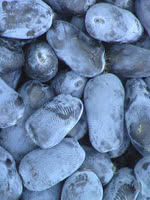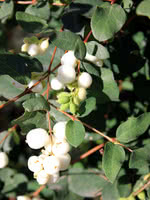Mon-Fri 9am - 5pm Mountain time
Common Snowberry vs Indigo Treat Haskap (Honeyberry)
Lonicera caerulea Indigo Treat
Symphoricarpos albus
NOT AVAILABLE THIS SEASON - MIGHT RETURN
Indigo Treat has fruit similar in size and firmness to their Tundra variety, making it suitable for commercial production or your home garden.
Indigo Treat, like the Borealis Haskap, does not self-pollinate well. We recommend another variety, such as Honeybee or Berry Blue Honeyberry, be planted at a minimum 1:8 ratio with it to boost fruit production. Many experts suggest the highest Haskap yield comes from fields planted with the most varieties.
Due to stronger interest in newer cultivars, 2015 will be our last year selling Indigo Treat.
Common Snowberry is a small deciduous shrub with characteristic white to pink flowers and clusters of white fruit.
This North American native species is very adaptable, and can be used for erosion control in riparian and restoration areas. Snowberry's fruit attracts wildlife, and livestock can consume the berries without issue.
Indigo Treat Haskap (Honeyberry) Quick Facts
Common Snowberry Quick Facts
Toxicity: berries toxic to humans

